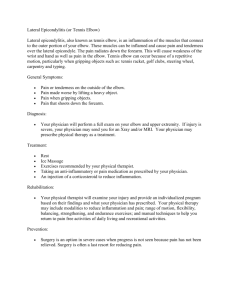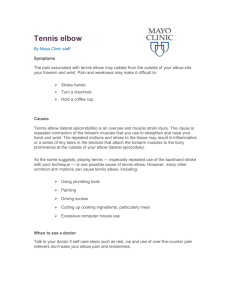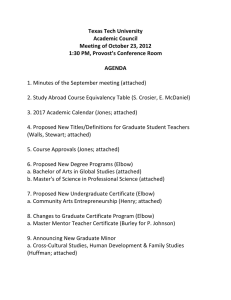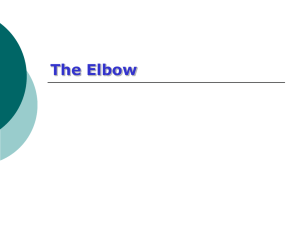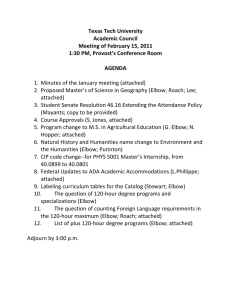Tennis Elbow
advertisement
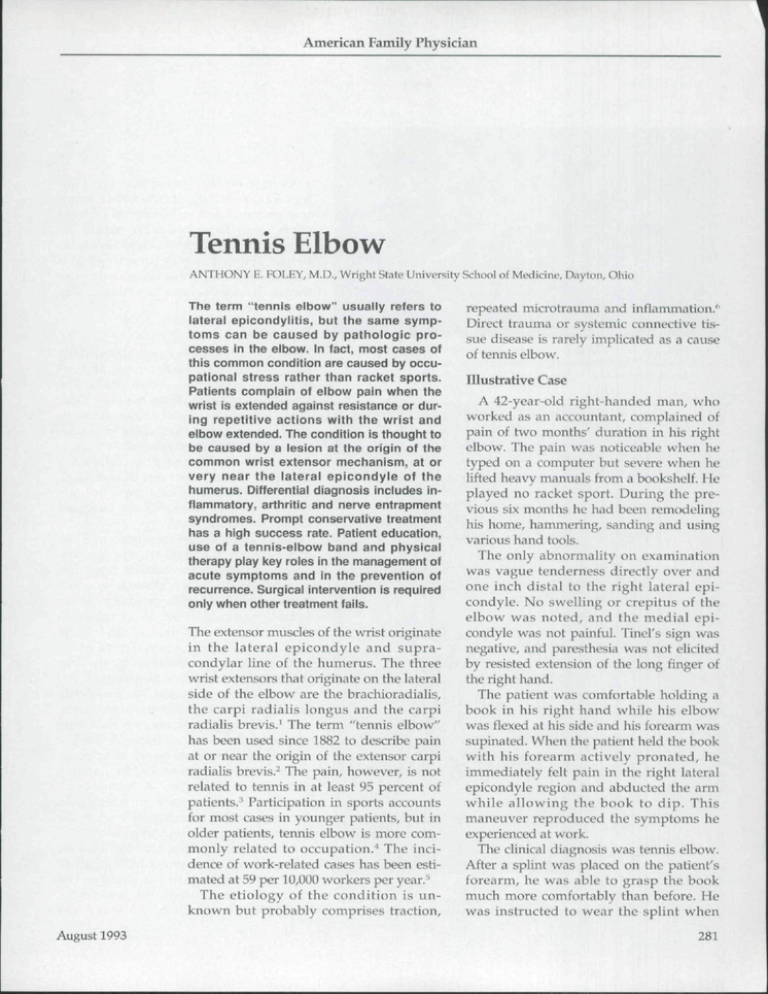
American Family Physician
Tennis Elbow
ANTHONY E. FOLEY, M.D., Wright State University School of Medicine, Dayton, Ohio
The term "tennis elbow" usually refers to
lateral epicondylitis, but the same symptoms can be caused by pathologic processes in the elbow. In fact, most cases of
this common condition are caused by occupational stress rather than racket sports.
Patients complain of elbow pain when the
wrist is extended against resistance or during repetitive actions with the wrist and
elbow extended. The condition is thought to
be caused by a lesion at the origin of the
common wrist extensor mechanism, at or
very near the lateral epicondyle of the
humerus. Differential diagnosis includes inflammatory, arthritic and nerve entrapment
syndromes. Prompt conservative treatment
has a high success rate. Patient education,
use of a tennis-elbow band and physical
therapy play key roles in the management of
acute symptoms and in the prevention of
recurrence. Surgical intervention is required
only when other treatment fails.
The extensor muscles of the wrist originate
in the lateral epicondyle and supracondylar line of the humerus. The three
wrist extensors that originate on the lateral
side of the elbow are the brachioradialis,
the carpi radialis longus and the carpi
radialis brevis.' The term "tennis elbow"
has been used since 1882 to describe pain
at or near the origin of the extensor carpi
radialis brevis.^ The pain, however, is not
related to tennis in at least 95 percent of
patients.^ Participation in sports accounts
for most cases in younger patients, but in
older patients, tennis elbow is more commonly related to occupation."^ The incidence of work-related cases has been estimated at 59 per 10,000 workers per year.^
The etiology of the condition is unknown but probably comprises traction.
August 1993
repeated microtrauma and inflammation.''
Direct trauma or systemic connective tissue disease is rarely implicated as a cause
of tennis elbow.
Illustrative Case
A 42-year-old right-handed man, who
worked as an accountant, complained of
pain of two months' duration in his right
elbow. The pain was noticeable when he
typed on a computer but severe when he
lifted heavy manuals from a bookshelf. He
played no racket sport. During the previous six months he had been remodeling
his home, hammering, sanding and using
various hand tools.
The only abnormality on examination
was vague tenderness directly over and
one inch distal to the right lateral epicondyle. No swelling or crepitus of the
elbow was noted, and the medial epicondyle was not painful. Tinel's sign was
negative, and paresthesia was not elicited
by resisted extension of the long finger of
the right hand.
The patient was comfortable holding a
book in his right hand while his elbow
was flexed at liis side and his forearm was
supinated. When the patient held the book
with his forearm actively pronated, he
immediately felt pain in the right lateral
epicondyle region and abducted the arm
while allowing the book to dip. This
maneuver reproduced the symptoms he
experienced at work.
The clinical diagnosis was tennis elbow.
After a splint was placed on the patient's
forearm, he was able to grasp the book
much more comfortably than before. He
was instructed to wear the splint when
281
American Family Physician
Tennis Elbow
working in his office or home, to avoid lifting and grasping objects when his forearm
was pronated and to lift objects with his
elbow closer to his body. The patient decided to arrange for help in remodeling his
house. Ibuprofen was prescribed at a
dosage of 600 mg three times daily with
meals. Six weeks later the patient was
much improved.
Diagnosis
FIGURE 1. The wrist and elbow are extended against a lu.id, showing the
location of the lateral epicondyle of Lhe humenis (A) and the location of
the extensor carpi radialis brevis muscle (B).
txtensor carpt
radialis brevis
m
FIGURE 2. Posterior aspect of right forearm,
showing extensor carpi radinlis brevis and the
area of pain associated with tennis elbow.
282
The illustrative case is typical in that the
patient played no racket sport and acquired his symptoms occupationally. The
site of pain in teimis elbow has been localized to the attachment of the extensor
carpi radialis brevis mechanism to the distal aspect of the lateral epicondyle {Figures
1 and 2). Scarring and granulation are
found at this site in patients treated surgically, but no single clinicopathologic
process has been unequivocally identified
as the cause of the pain.^
Tennis elbow occurs most often in white
men between 30 and 60 years of age. The
dominant side of the body is more frequently affected. Tennis elbow is reportedly rare in blacks." The reported duration of
symptoms ranges from three weeks to
three and one-half years, with an average
duration of six to 12 weeks. Tennis elbow
is usually a chronic condition by the time
the patient seeks medical treatment.
The diagnosis is clinical. No completely
reliable or pathognomonic sign exists.
Tenderness usually occurs over the lateral
epicondyle or one to two inches distally, or
at both sites. The pain decreases gripping
power and can be provoked by resisting
extension of the wrist." A "coffee-cup"
sign has been described, in which pain
occurs at the lateral epicondyle when the
patient picks up a full cup of coffee.'"
A heavy book (about 6 Ib) can be used
both as an aid to diagnosis and for patient
education on how to lift objects. The
patient with tennis elbow can hold a book
with little or no pain if the elbow is flexed
volume 48, number 2
American Family Physician
TABLE 1
Differential Diagnosis of Tennis Elbow
FIGURE 3. When a heavy book is held with the elbow flexed and adducted, the patient with tennis elbow does not experience pain.
FIGURE 4. iiop) Gr.isping a heavy bonk while the forearm is pronated
causes immediate pain in the elbow, followed quickly (bottom) by elbow
abduction, allowing the book to dip below the level of the elbow.
August 1993
Neuropathic
Radial tunnel syndrome
Entrapment of posterior interosseous nerve
Entrapment oi musculocutaneous nerve
Entrapment of median nerve (pronator syndrome)
Ulnar entrapment syndromes
Inflammatory
Radiocapiteliar arthritis
Synovitis
Gouty arthritis
Joint space infection
Trauma
I^dial neck fracture
Distal humerus fracture
Referred pain
Cervical radiculopathy
Shoulder arthritis
Carpal tunnel syndrome
Angina pectoris
Other
Lateral epicondylitis (most common)
Medial epicondylitis
Tumor (primary or secondary)
Bone cyst
and adducted with the forearm supinated
(Figure 3). However, when holding the
book with the forearin pronated, the
patient experiences immediate pain in the
lateral epicondyle region, abducts the
elbow and allows the book to dip below
the level of the elbow {Figure 4).
The most common examination technique is palpation at and just distal to the
affected lateral epicondyle while the examiner resists the patient's wrist extension. Because the extensor carpi radialis
brevis inserts on the third metacarpal
bone, some examiners prefer to use resistance against extension of the third, or
long, finger rather than the entire wrist.
This test (resisted wrist/finger extension),
however, can produce variable temporary
paresthesia in patients with radial tunnel
syndrome. Passive pronation and supination of the forearm and extension and flexion of the elbow do not cause pain in
patients with lateral epicondylitis.
Conditions that must be differentiated
from tennis elbow are listed in Table 1.
The five possible nerve entrapment syn283
American Family Physician
Tennis Elbow
Area of pain
Area of paresthesia
Area of pain
Site of entrapment
Posterior
interosseous nerve
FIGURE 5. Entrapment sites of the radial nerve Ueft) and the posterior interosseous nerve {right) and
areas of associated pain and paresthesia.
The Author
ANTHONY E. FOLEY, M.D.
is assistant professor of family practice at
Wright State University School of Medicine,
Dayton, Ohio, and a teacher in lamily practice
at St. Elizabeth Medical Center, Dayton. Dr.
Foley graduated from the Ohio State University College of Medicine, Columbus, and completed a residency in family practice at the
University of Missouri-Columbia School of
Medicine, Columbia.
284
dromes present the greatest diagnostic
challenges."'•The radial nerve can become compressed in the radial tunnel as it courses
laterally around the posterior surface of
the humerus and pierces the lateral muscular septum (Figure 5). Pain from radial
nerve compression may be referred to the
lateral epicondyle region, and paresthesias
may occur in the distribution of the superficial radial nerve. With radial nerve
compression, a Tinel's sign over the radial
volume 48, number 2
American Family Physician
Area of decreased
sensation
FIGURE 6. Entrapment sites of the musculocutaneous nerve Heft) and the median nerve (right) and
associated areas of pain and decreased sensation.
head is possible, as well as tenderness to
muscle palpation approximately 4 cm distal to the lateral epicondyle. The most
common finding is pain when the arm is
supinated against resistance while the
elbow is extended. Weakness of full-finger
extension and limited extension of the
elbow may be noted.
•The posterior interosseous nerve (deep
branch of the radial nerve) can become
trapped within the supinator muscle
(Figure 5). Such entrapment produces weakness of fifth-finger extension and pain at
August 1993
the elbow, making the condition difficult to
distinguish from radial tunnel syndrome.
• The musculocutaneous nerve can be
compressed by the bicipital aponeurosis
and tendon against the brachial fascia, resulting in pain in the anterolateral elbow
and decreased sensation in the radial volar
forearm (Figure 6).
•The median nerve can be compressed
at four different sites in the forearm
(pronator syndrome), producing pain in
the volar forearm that worsens with repetitive use (Figure 6). Pain can be provoked
285
American Family Physician
Tennis Elbow
by resisting pronation or by resisting flexion at the proximal interphalangeal joint of
the third finger.
•Tlie ulnar nerve can be trapped in the
elbow or forearm, although the pain occurs
in the medial forearm or hand (Figure 7).
Tennis elbow usually causes no visible
swelling. If swelling is present, arthritis,
synovitis, infection, trauma and tumor
should be diagnostic considerations.
Inflammation can develop in the radiocapitellar bursa, as well as the synovial
insertion at the elbow. Gout can produce
FIGURE 7. Entrapment site ol tliu ulnar ner\u
and area
286
swelling in the elbow." Joint space infection and primary or metastatic tumors are
differential possibilities but rarely are
manifested by point tendeniess at or near
the lateral epicondyle.
Elbow pain can represent pain from cervical radiculopathy or carpal tunnel syndrome."^ Rarely, the pain of angina pectoris
is referred to the elbow. A history of
falling or trauma should elicit a search for
fracture, especially of the radial neck.
Lastly, medial epicondylitis produces pain
over the medial epicondyle of the humerus. Tine condition is known as golfer's
elbow, although it also occurs in baseball
pitchers and tennis players. This misnomer highlights the confusion caused by
appending a sport's name to a medical
condition.
Treatment
Patient education, protection of the
painful elbow and avoidance or modification of aggravating actions are critical factors in the treatment of tennis elbowj''
Treatment begins with teaching the patient
lifting techniques that will protect the
elbow. Lifting objects with the palm close
to the body is comfortable to patients with
tennis elbow; lifting with the elbow extended and forearm pronated is not.
A tennis-elbow band may be beneficial.
To determine whether wearing a tenniselbow band would be helpful in a particular patient, a blood pressure cuff can be
placed on the affected forearm and inflated to midway between systolic and
diastolic blood pressure, to simulate a tennis-elbow band. When the patient grasps a
book (as previously discussed), a reduction in discomfort would demonstrate the
utility of the band. A tennis-elbow band
could then be prescribed, to be worn during daytime hours {Figure 8).
Two general types of bands are available: static and counterforce. The static
band wraps around the forearm and applies equal pressure to all areas of the forevolume 48, number 2
American Family Physician
FIGURE 8. rUicement oi a tennis-elbow band, with the pad over the extensor surface of the forearm.
arm. The counterforce band applies most
of the tightness directly over the extensor
mechanism of the forearm.
In severe cases, instead of a forearm
band, a cock-up splint can be placed at the
wrist, to provide 20 degrees of extension.
Splinting shortens the extensor musculature and reduces the drag on the origin of
the extensor brevis muscle at the lateral
epicondyle.
A nonsteroidal anti-inflammatory drug
(NSAID) is a rational therapy.'"^ Corticosteroid injection may be helpful, especially
if the patient has disabling pain at the time
of initial presentation or if symptoms do
not respond to rest, banding and NSAID
therapy. An injection of crystalline steroid
and local anesthetic can be administered
with a 25-gauge needle at the lateral epicondyle and in several other sites, up to
one inch distal to the epicondyle. This
technique spreads the medication and
may prevent corticosteroid-induced skin
atrophy. The patient should be instructed
to apply ice to the area after the injection
and to rest the elbow for two to three
weeks."'-'^ After injection, pain commonly
flares for several days. Postinjection application of ice may prevent this flare.
Rehabilitation
Rehabilitation is crucial to prevent recurrence of tennis elbow."*''^ After the pain
has subsided, the patient should begin
performing stretching exercises of the
extensor forearm muscles. After passive
stretching, the patient should begin performing strengthening exercises for the
forearm muscles by using a 1-lb weight
{Figure 9).
FIGURE y. When trcL' ot pain, i\w pjtieiit begins strengthening the forearm, using a 1-lb weight.
August 1993
Strong consideration should be given to
a formal rehabilitation program for patients with lateral epicondylitis related to
occupational or sports activities. Strategies
must be developed to avoid repeated forearm stress. An occupational program may
involve a physical therapist or an occupational therapist, or both, as well as a worksite visit. For sports-related cases, the program may include consulting a tennis
professional to correct faulty backhand
technique or racket selection.
Finally, surgery plays a role in the treatment of unresponsive, disabling lateral
287
American Family Physician
Tennis Elbow
epicondylitis.^" Surgery may be considered
if one or more of the following conditions
exists; severe pain in the epicondylar area
for at least six months, no response to two
weeks of immobilization and no response
to two local injections of corticosteroids.
Several surgical techniques are available.
One technique-" involves percutaneous
release of epicondylar muscles. Another
technique^" is more extensive and aims not
only at releasing the origin of the extensor
carpi radialis brevis but also at excising
any inflamed or pathologic tissue. Surgery
has a diagnostic as well as a therapeutic
aspect, because pathologic processes such
as radial nerve entrapment may be discovered during surgery.
The author thanks Rick Berkey, coordinator of photography services at St. Elizabeth Medical Center,
Dayton, Ohio, for technical assistance.
REFERENCES
1. Hoppenfeld S, Hutton R. Physical examination of the spine and extremities. New York:
Appleton-Century-Crofts, 1976.
2. Burgess RC. Tennis elbow. [ Ky Med Assoc
3. Chop WM Jr. Tennis elbow. Postgrad Med
1989;86:301-4,307-8.
4. Gellman H. Tennis elbow (lateral epicondylitis). Orthop Clin North Am 1992;23:
75-82.
5. Kivi P. The etiology and conservative treatment of humeral epicondylitis. Scand ]
RehabU Med 1983;15:37-41.
6. Kamien M. A rational management of tennis
eibuw. Sports Med 1990;9:173-91.
288
7. Doran A, Gresham GA, Rushton N, Watson
C. Tennis elbow. A clinicopathologic stxidy of
22 cases followed for 2 years. Acta Orthop
Scand 1990;61:335-8.
8. Coonrad RW, Hooper WR. Tennis elbow: its
course, natural history, conservative and surgical management. } Bone Joint Surg lAm|
1973;55:1177-82.
9. Sheon RP, Moskowitz RW, Goldberg VM.
Soft tissue rheumatic pain: recognition, management, prevention. 2d ed. Philadelphia:
Lea & Febiger, 1987.
10. Coonrad RW. Tennis elbow. Instr Course
Lectl986;35:94-Un.
11. Morgan RF, Terranova W, Nichter LS,
Edgerton MT. Entrapment neuropathies of
the upper extremity. Am Fam Physician
1985;31(I):123-34.
12. Gersner DL, Omer GE. Peripheral entrapment neuropathies in the upper extremity. J
Musculoskeletal Med 1988;March: 14-29.
13. Wilson JD, ed, Harrison's Principles of internal medicine. 12th ed. New York: McGrawHill 1991:1835.
14. Fillion PL. Treatment o( lateral epicondylitis.
Am J Occup Tlier 1991;45:340-3.
15. Birrer RB, ed. Sports medicine for the primary
care physician. Norwalk, Conn.: AppletonCentury'-Crofts, 1984.
16. Athletic training and sports medicine.
Chicago, 111.: American Academy of Orthopaedic Surgeons, 1984.
\7. Millar AP. Sports injuries and their management. Baltimore: Williams & Wilkins, 1987.
18. Wood M, Knight NC. Tennis elbow: its clinical course, etiology and treatment. J Arkansas
Med StK- ]989;85:499-500.
19. Prentice WE, ed. Rehabilitation techniques in
sports medicine. St. Louis: Times Mirror/
Mosby College Publications, IWO.
20. Crenshaw AH, ed. Campbell's Operative
orthopaedics. 7th ed. St. Louis: Mosby, 1987.
volume 48, number 2
